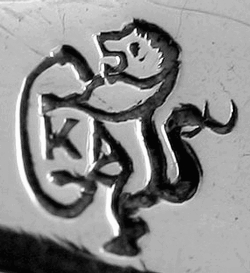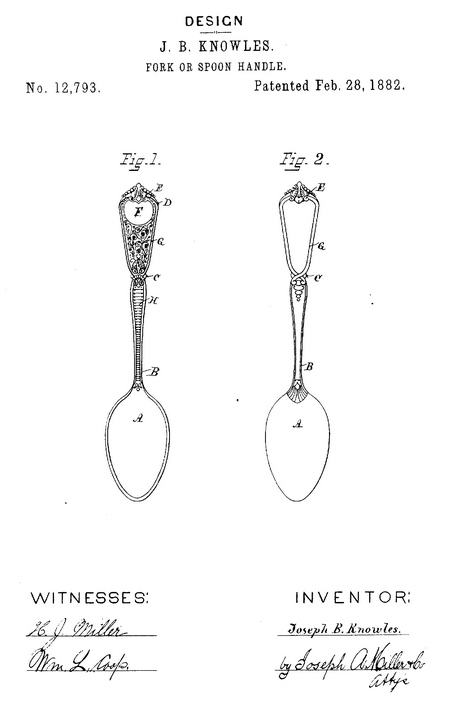Joseph Brown Knowles
- Born: 15 Dec 1829, Providence RI
- Died: 2 Jan 1891
General notes:
Silversmith and jeweler
Events in his life were:
- He appeared on the census in 1850 in Providence RI. Listed in his father's houshold as a jeweler.
- He appeared on the census in 1860 in Providence RI. Listed as a silversmith.
- Partnership: Samuel J. Ladd, in 1864-1875, in Providence RI. As KNOWLES & LADD. Though Ladd retired as partner in 1875, he continued to work and design for the firm until his death in 1886. 12
- He appeared on the census in 1870 in Providence RI. Listed as a silversmith.

- Partnership: Stephen M. Knowles, in 1875-1891, in Providence RI. As J. B. & S. M. KNOWLES, with a sales office at 20 Maiden Lane, New York City. 12
- He appeared on the census in 1880 in Providence RI. Listed as a silversmith.

- Patent: 12,793, on 28 Feb 1882. JOSEPH B. KNOWLES, OF PROVIDENCE, RHODE ISLAND.
DESIGN FOR A FORK OR SPOON HANDLE.
SPECIFICATION forming part of Design No. 12,793, dated February 28, 1882. Application filed December 27, 1881. Term of patent 7 years.
To all whom it may concern:
Be it known that I, JOSEPH B. KNOWLES, a citizen of the United States, residing at Providence, in the county of Providence and State of Rhode Island, have invented and produced a new and original Design for Fork or Spoon Handles, of which the following is a fall, clear, and exact description, reference being had to the accompanying drawings, forming part of this specification.
Figure 1 is a front view of my newly-designed spoon-handle, and Fig. 2 is a rear view of the same.
Heretofore the handles for spoons and forks have been made wide at the ends farthest from the bowl or tines, gradually diminishing in width till near the junction with the bowl or tines, when the handle again rapidly increased in width. Such handles have also been made with a medallion and other ornamental enlargement at a point nearly midway between the narrowest and the widest portion of the handle. Such handles have heretofore been ornamented within a line or border formed along the edge of the handle.
The leading feature of my design consists in contracting the wide end of the handle more rapidly and curving the edges inward at a point nearly midway between the narrowest part of the handle and the end thereof, then curving outward, increasing the width of the handle rapidly, then decreasing the width thereof until it again increases in width near the bowl or the tines; and the ornamentation of the handle consists in a border-fillet nearly surrounding the wide end of the handle, the upper ends of which represent a cornucopia, and the lower ends cross each other on the back of the spoon or fork at the contracted portion about midway of the handle, the space between such border being ornamented with any desired design, leaving a shield near the upper end, as shown in Fig. 1.
In the drawings, A is the bowl of a spoon. B is the narrow portion of the handle near the bowl. C is the suddenly-contracted portion of the handle. D is the widest part of the handle. E E are the enlarged ends of the border G. F is the shield, on which the initials may be engraved. II is the ornamentation representing basket-work between the border-fillet.
Having thus described my newly-conceived design, I claim as new and desire to secure by Letters Patent—
1. The design for spoon and fork handles herein shown and described, the same consisting of the outline of the handle, diminishing in width from the widest part and suddenly curving inward at C, thence curving outward, increasing the width, then diminishing gradually to the narrowest portion at B, substantially as shown and described.
2. The design for back of spoon and fork handles herein shown and described, the same consisting of a border-fillet nearly surrounding the broad ends of the handle, the upper end of each fillet ending in the ornament E, and the lower ends crossing each other at the contracted portion C. as described.
Joseph B. Knowles
Witnesses:
M. E. Emerson
J. A. Miller, Jr.
|



